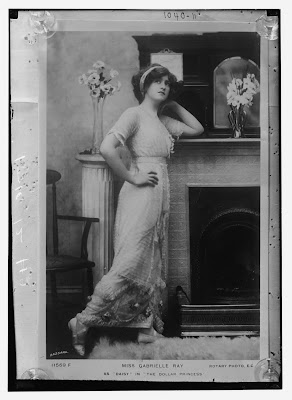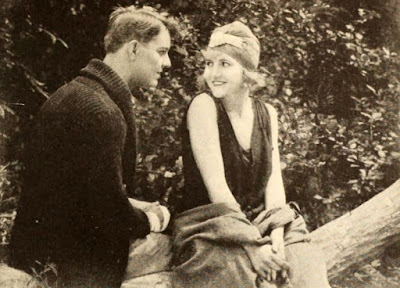This article was originally published in Discover Your Ancestors Online Periodical in January 2019
Republishing this today on my blog to see what it might add to the debate!
 |
The Dollar Princess: Miss Gabrielle Ray (1883-1973) as Daisy in the Edwardian musical comedy ‘The Dollar Princess,’ which took a satirical
look at American heiresses, London, 1909. Bassano
Photo, Bain News Service,Via Wikimedia Commons.
|
With actress
Meghan Markle marrying Prince Harry in May 2018, the issue of how we Brits perceive
American women has been a matter of great public interest in recent times. Markle
is of course bi-racial, with an African-American mother and a white father (a
background that inevitably complicates public reaction to her), but the white American
women who came to Britain in the past in one capacity or another have, in fact,
always provoked debate and controversy.
Looks and Health
As with much
historical commentary on women, it was the appearance of American females that caught
the attention of many British commentators and there were many positive
attributes to admire. The Manchester
Courier and Lancashire General Advertiser (May 14th 1892) commented on their
overall robustness, ‘the frankness of their eyes, the naturalness of their
emotions and their general genuineness.’ In November and December 1882, many
English newspapers, carried further approbation (quoting research conducted by
the North American Review) suggested
that the health of American women was better than that of their British sisters
and that consequently, ‘the period of possible maternity is two years longer in
American women than in the women of other English-speaking nations!’
Fashion
and Expenditure
Known by the
British mostly in their role as performers (actresses on the stage and later
screen), tourists and heiresses – transatlantic women were stereotypically
described as being the owners of large leather Saragota trunks stuffed with expensive
clothing. In 1910, the Aberdeen Press and
Journal published an article entitled ‘American Women’s Extravagance’ which
described the phenomenon of the affluent US dame with a mixture of disgust and
envy: ‘It seems that there are 100 women
in New York known to spend 150,000 dollars every year in dress, more than 1000
others lay out $75,000 on the toilette; 15,000 others have to make 3,000
dollars suffice.’
The same
newspaper also made the rather unlikely claim that American women used ‘milk or
champagne […] for the morning bath,’ and cited the shocking example of ‘a
little dog owned by one wealthy woman which was wrapped in a coat of real
ermine and had a collar of diamonds.’ Diamonds, indeed, were a big feature of
British commentary on the lavishness of the American female. The previously-mentioned
article went on to claim that American women… have millions of pounds worth of
diamonds quite apart from their collections of other stones. The jewels are
worn according to the occasions, and one woman will be heard asking another
about her ‘summer diamonds’ and her ‘winter diamonds’ and so on.’ It was also noted
that such women wore jewellery in the daytime as well as during the evening –
something that, to the British, smacked of gross vanity and self-indulgence. American
men, pointed out the same article, were quick to justify their womenfolk’s
profligacy “‘Why,’ says an American when any criticism of the way in which his
country women spend, ‘it is their own money. Their husbands made it; why should
they not spend it as they like?’”

Woman with Book Woman
with Book by William McGregor Paxton, c. 1910. The
American novelist, Henry James, - who might be supposed to have been rather
biased in his opinions - once commented
that ‘one of her charms is that she does not make a guy of herself,’ and
opined that ‘if [he] had to be born again, [he] would shout at the top of his
voice, ‘Make me an American woman.’
Via Wikimedia Commons. New Britain Museum of American Art, Connecticut.
Temperament
and Talk
Whilst the
American journalist Nellie Bly (1864-1922) found British women
‘over-sheltered’, too confined to the home and, most shockingly, not at all inclined
to express their opinions, British men found US women strident and forthright,
very willing to put forward their point of view whether or not they were asked
for it. Indeed, on this side of the Atlantic, there was a general horror at the
garrulousness of American women. In September 1896 the London Daily News reported with disgust how an American bride had
walked down the aisle on the arm of her father ‘chatting and laughing as
unconcernedly as if she was in a ballroom’. The same article concluded that ‘the
American woman is unquestionably a terror to many of the sterner sex.’
American Women Smoking This
Punch cartoon, showing an
unattractive woman smoking in a tunic and trousers, was the stereotype of a
certain type of masculine American woman in London in the mid-nineteenth
century. Punch, 1851, Via
Wikimedia Commons
Education
and equality
In general, American
women were considered to have had better education and to enjoy greater legal rights
than their British counterparts. It was remarked that in some States, more
severe punishments were meted out to husbands who had committed domestic
violence, and that there was better access to divorce, than in Britain. These
supposed social advancements were decried by some and critics drew attention to
the fact that, despite their superior education, very few American women had
produced anything of any worth in the world of art and literature (The London Daily News, September 30th,
1896). Others, however, saw the more egalitarian education of American females
as something to which Britain ought to aspire. In a series of articles
comparing British culture to that of other countries, Sir Charles Dilke wrote,‘there
is far greater equality of the sexes in America than there is here for the
simple reason that American women are educated to be much more independent and
self-reliant than ours.’ (The Eastern
Daily Press, April 30th, 1887)
The
Dollar Princesses
In the late
nineteenth and early twentieth centuries, several prominent members of the
British aristocracy were particularly ‘delighted and captivated’ by American
women. Despite some public repugnance at
transatlantic marriages, it was generally acknowledged that the fortunes of
these ‘dollar princesses’ were helping to shore up the fortunes of our
crumbling nobility. Some American-British nuptials left an important social and
political legacy. More often than not such alliances were presented to the
public as hotbeds of infidelity, outlandish
fashion and obscene wealth. Jennie Jerome (1850 or 1854-1921), a society beauty
from Brooklyn, married Lord Randolph Churchill in 1874 and became the
mother of British Prime Minister Winston Churchill. After the death of
Winston’s father in 1895, Jennie married two further ‘toy-boy’ husbands (one of
whom nickamed her ‘Pussycat’) and died after tripping down a friend’s staircase
whilst wearing a new pair of high-heeled shoes!
Fanny Burk (1857-1947 was an American heiress who appeared in the Four
Hundred – an index to New York’s ‘best families.’ She married the Honourable
James Boothby Burke Roche (later third Baron Fermoy) and would become the
great-grandmother of Diana, Princess of Wales. After her divorce in 1891, she
was the subject of a well-publicised trial in which her husband accused her of
keeping their daughter prisoner!
Chicago-born Mary Leiter (1870-1906), the
model for Lady Grantham in TV’s Downton Abbey, married Conservative M.P. George
Curzon, (later Lord Curzon of Kedleston) and subsequently became Vicereine of
India. Though she gained notoriety as ‘the best dressed woman in the world,’ wearing
a dress adorned with peacock feathers at the Coronation of Edward VII, Leiter was
also known for her compassion, opening hospitals for women in India and helping
to save an endangered species of rhinoceros.
|
|
Mary Leiter: Mary
Leiter, American wife of Lord Curzon. A striking and ‘curvaceous’ beauty at 6
foot 2, this popular ‘dollar princess’ acquired two inherently British titles:
Baroness Curzon of Kedleston and
Viceriene of India. Portrait
by Franz von Lenbach, 1902. Via Wikimedia Commons
|
By the time then that twice-divorced Wallis Simpson appeared as the love
interest of the future Edward VIII in the mid 1930s, the British public had already
had a whole host of extraordinary, multiply-divorced and controversial American
women to draw upon. Simpson’s almost universal vilification was, therefore,
just about unavoidable and it intensified when Edward abdicated in order to
marry her. With this background, Megahn Markle can be forgiven if she
approached her new role as the Duchess of Sussex with some trepidation!

|
| If Only Women Knew:
Virginia
Lee and Robert Gordon in the American film, ‘If Women Only Knew,’1921. Accounts
and images of female actresses on stage and screen – in which they invariably
appeared to have more independence and freedom than British women - were just about the only source of
information on American women a century ago, and necessarily distorted public
opinion. Via Wikimedia Commons. Still from the American film If Women Only Knew,
Cayuga Pictures, from an
advert on page 79 of the magazine Photoplay, (August 1921) |
Regular American Girls
Those US
ladies who married into the aristocracy were objects of fascination and
vilification in the British press, but it should be remembered that these
opinions were based on general impressions of a very small group of people - the wealthy set or ‘It’ girls of the time,
if you like, - in New York. But, thousands of ordinary women of American birth
can also be found in the decennial British censuses (by typing in the optional
keyword 'American' on the commercial genealogical website www.findmypast.co.uk, for example).To pick a few at
random, these women include 30 year old Elsie Abeling, a ‘singer-vocalist’ from
‘Richmond, America’, who found herself a patient at Chelsea Hospital, Hastings,
on the night of the 1901 census; and Edith Butler, (a 21 year old servant to a
rich family in Birkenhead) and Mary Allen (the 42 year old wife of a grain
merchant’s horseman in Bodmin), both of whom described themselves as ‘American
subjects’ on that same census.
An American Girl in London: ‘An American Girl in London’ by Everard Cotes, (1891). Many young
American women came to London to work, and in the expectation of marrying, at
the turn of the nineteenth and twentieth centuries. Via Wikimedia Commons.
Perhaps your
ancestors too were among these many US girls who came to Britain to visit, work
or settle around a century ago. If so, it’s worth thinking about how they might
have been received by the families into which they married and the people
living in the neighbourhoods they frequented. Their integration into British
society might have been smoother than that of those immigrants who spoke other
languages or who came from more different backgrounds, but they carried a
weight of expectation – positive and negative - all of their own.
Useful
Books and Websites
William H. Chafe, The Paradox of Change: American Women in the
20th Century, Oxford University
Press, 1991.
Anne
de Courcy, The Husband Hunters: American
Heiresses Who Married Into the British Aristocracy, Macmillan USA, 2018.
Carol
Faulkner, ed, Women in American History
to 1880: A Documentary Reader, Wiley Blackwell, 2011.
Blanche McManus, The American Woman Abroad, lulu.com. 2012 (originally published
1911).
#meghanmarkle #princeharry #wallissimpson #edwardviii #americanwomen #american #dollarprincesses #women'shistory #history #heiresses #britishhistory #royalfamily #megxit #megexit
.












